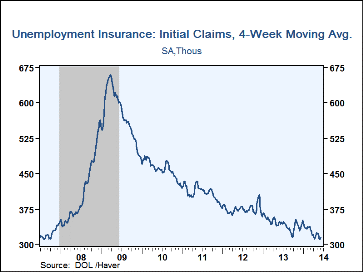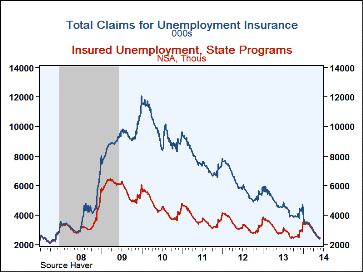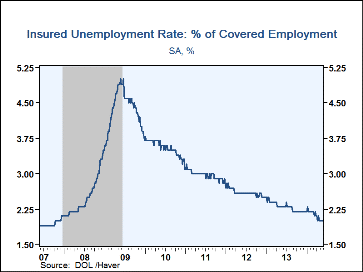 Global| Jun 12 2014
Global| Jun 12 2014U.S. Initial Claims for Jobless Insurance Recover to Three-Week High
by:Tom Moeller
|in:Economy in Brief
Summary
The rate of labor market improvement is evening out. Initial claims for jobless insurance increased to 317,000 during the week ended June 7 from 313,000 in the prior week, revised up from 312,000. A 315,000 level of claims was [...]
The rate of labor market improvement is evening out. Initial claims for jobless insurance increased to 317,000 during the week ended June 7 from 313,000 in the prior week, revised up from 312,000. A 315,000 level of claims was expected in the Action Economics Forecast Survey. Claims remained slightly higher than the 298,000 low in early-May. The four-week moving average of initial claims rose to 315,250. During the last ten years there has been a 75% correlation between the level of claims and the m/m change in nonfarm payrolls.
Continuing claims for unemployment insurance in the week ended May 31 nudged up to 2.614 million (-12.3% y/y). The four-week moving average fell to 2.622 million, a seven year low. The insured rate of unemployment remained at 2.0% for the sixth straight week, its cycle low. This particular count covers only "regular" programs and does not include all extended benefit and other specialized jobless insurance programs. In the week of May 24, the latest available, the total of all benefit recipients fell to 2.447 million (-45.8% y/y), also the cycle low. This broader measure is not seasonally adjusted. It compares to a cycle peak of 12.060 million in January 2010 and pre-recession figures that averaged 2.596 million in 2007. Year-on-year comparisons are impacted by the expiration of the Emergency Unemployment Compensation program at the end of 2013.
By state in the May 24th week, the insured rate of unemployment continued to vary greatly with South Carolina (1.00%), Virginia (1.02%), Louisiana (1.06%), Tennessee (1.13%), Texas (1.39%) and Maine (1.76%) at the low end of the range. At the high end were Michigan (2.10%), Illinois (2.35%), California (2.68%), Pennsylvania (2.70%), Connecticut (2.76%) and New Jersey (2.82%). These data are not seasonally adjusted.
Data on weekly unemployment insurance are contained in Haver's WEEKLY database and they are summarized monthly in USECON. Data for individual states are in REGIONW. The expectations figure is from the Action Economics survey, carried in the AS1REPNA database.
| Unemployment Insurance (000s) | 06/07/14 | 05/31/14 | 05/24/14 | Y/Y % | 2013 | 2012 | 2011 |
|---|---|---|---|---|---|---|---|
| Initial Claims | 317 | 313 | 304 | -5.9 | 343 | 375 | 409 |
| Continuing Claims | -- | 2,614 | 2,603 | -12.3 | 2,977 | 3,319 | 3,742 |
| Insured Unemployment Rate (%) | -- | 2.0 | 2.0 | 2.3 (5/13) |
2.3 | 2.6 | 3.0 |
| Total "All Programs" (NSA) | -- | -- | 2.447 mil. | -45.8 | 4.651 mil. | 6.049 mil. | 7.725 mil. |
Tom Moeller
AuthorMore in Author Profile »Prior to joining Haver Analytics in 2000, Mr. Moeller worked as the Economist at Chancellor Capital Management from 1985 to 1999. There, he developed comprehensive economic forecasts and interpreted economic data for equity and fixed income portfolio managers. Also at Chancellor, Mr. Moeller worked as an equity analyst and was responsible for researching and rating companies in the economically sensitive automobile and housing industries for investment in Chancellor’s equity portfolio. Prior to joining Chancellor, Mr. Moeller was an Economist at Citibank from 1979 to 1984. He also analyzed pricing behavior in the metals industry for the Council on Wage and Price Stability in Washington, D.C. In 1999, Mr. Moeller received the award for most accurate forecast from the Forecasters' Club of New York. From 1990 to 1992 he was President of the New York Association for Business Economists. Mr. Moeller earned an M.B.A. in Finance from Fordham University, where he graduated in 1987. He holds a Bachelor of Arts in Economics from George Washington University.










